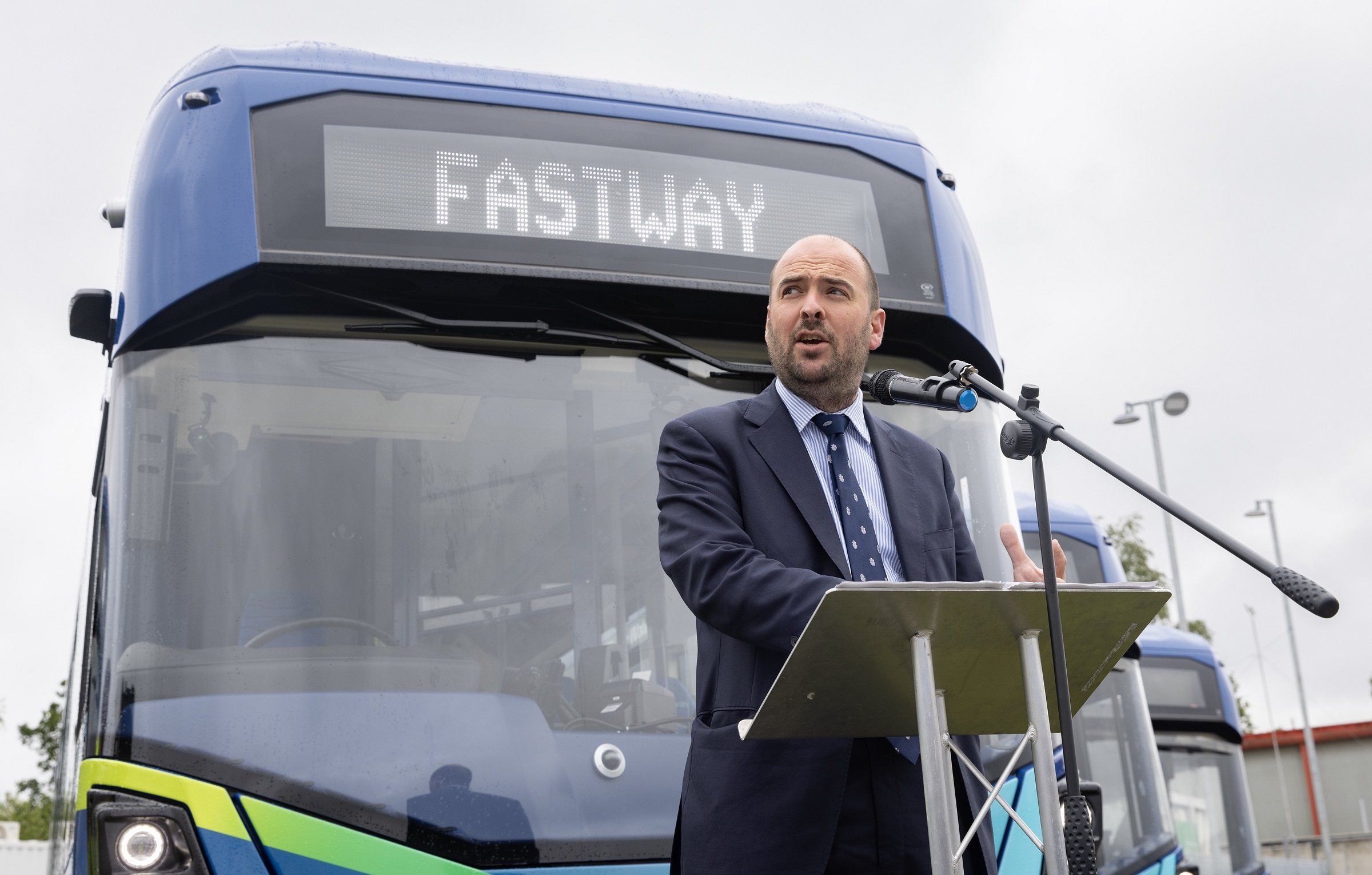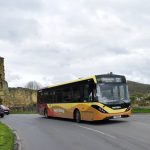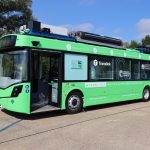Hydrogen fuel cell-electric remains the most realistic zero-emission technology for usage cases requiring very high mileage and utilisation capabilities. That is the verdict from the Go-Ahead Group after its Metrobus subsidiary launched 20 Wrightbus GB Kite Hydroliner single-deckers on 29 June.
They will be used on Fastway services around Crawley and Gatwick Airport. Travel patterns there influence Fastway scheduling, and buses can be called upon to work 22-hour duties before the opportunity arises to replenish their onboard energy storage.
Metrobus and Brighton and Hove Buses Managing Director Ed Wills says that modelling of zero-emission on the routes in question shows that only hydrogen gives the necessary endurance without an associated need to increase fleet size. That is an important consideration; Metrobus’s Crawley depot is congested, and provision by Air Products of a liquid hydrogen station – the first one in Europe to be deployed at such a scale for refuelling vehicles – has taken some space previously used for parking.
Go-Ahead Group Chair Claire Hollingsworth, who was present at the launch alongside Under-Secretary of State for Transport Richard Holden and other stakeholders and dignitaries, underlines the need for hydrogen on Fastway. “These are the most intensive routes in the Go-Ahead network,” she explains. “We need 300 miles of range and have little time to plug in.”

Go-Ahead currently has 450 zero-emission buses. All bar the 20 Hydroliners with Metrobus are battery-electric. The overall total in a year’s time will be 900. While there is no suggestion that hydrogen will usurp battery-electric as the group’s dominant emission-free technology, Claire notes opportunity for further hydrogen buses on longer or highly intensive routes. She also highlights the group’s coach fleet as a potential user of the element in the future.
Metrobus hydrogen fuel cell-electric fleet soon to grow to 54
In the meantime, Metrobus’s hydrogen fleet at Crawley will grow beyond the 20 Hydroliners thanks to collaboration with Surrey County Council (SCC). It is providing £16 million to fund 34 additional hydrogen fuel cell-electrics over the coming 18 months. They will be used on services in Surrey and be Hydroliners from Wrightbus in a mix of GB Kite single-deckers and StreetDeck double-deckers. SCC is also funding significant additional bus priority.
Neither measure is supported by central government cash. Instead, they form part of Surrey’s work around net zero, which it aspires to achieve by 2050. “Buses are at the heart of that,” says Cabinet Member for Transport, Infrastructure and Growth Matt Furniss.
The Fastway buses are dual-door to suit their high passenger turnover application. Much thought has gone into interior specification and how it works for disabled people. Brighton and Hove Buses and Metrobus Accessibility and Communities Manager Victoria Garcia OBE has taken a close interest in the fleet. Included are two spaces for wheelchair users among many other measures.

“The design of a bus really matters for accessibility,” she explains, noting that dementia-friendly flooring is also fitted across the two operators’ fleets. While such work could be viewed as an additional cost by some, Victoria counters by saying that it makes commercial sense.
The Purple Pound – the spending value of disabled households – is £274 billion per year, she points out. Wrightbus has outlined a desire to learn more about disabled bus users’ needs in a bid to further increase the appeal of its vehicles to those customers.
Liquid hydrogen storage is key to large-scale deployment
While the Hydroliners are the most visible part of the work done by Metrobus, a lot has gone on behind the scenes to support them. Engineers from Crawley have been to Ballymena to learn about the vehicles, and drivers are subject to an over two-hour training session. Some of that covers the theory of handling an electric bus and the rest is on road.
All maintenance will be done in-house. But Wrightbus has staff on site daily to support the vehicles, as it does in other locations where its zero-emission products are in service. That is a policy enacted recently and Ian Gillott, Managing Director of associated Bamford Bus Company business AllServiceOne, says it will be replicated elsewhere in the future.
The fuelling station from Air Products utilises ‘green’ liquid hydrogen produced in Immingham from imported renewable energy sources. It arrives at Crawley via tanker and is decanted into storage vessels on site, where up to 5,000kg can be held. The hydrogen is converted to gas as it is transferred to the buses.

Around 18 bus parking spaces have been sacrificed for the hydrogen station. That is a lot, but Air Products Hydrogen for Mobility Director UK Manish Patel says that the facility’s footprint is now fixed, and that it could support a full conversion of the over 100 buses at the depot to hydrogen.
“There are three advantages to using liquid hydrogen to fuel a large fleet,” Manish continues. “It is bunkered in large quantities to give security of supply. The footprint of a liquid hydrogen station is much smaller than it would be if the full fleet at Crawley was serviced by hydrogen stored as gas. And no air compressors are required.”
Government confidence as minister attends Metrobus hydrogen launch
Richard Holden was keen to sing the praises of the bus industry and the government’s provision of funding to back it in his keynote address. The Hydroliners are supported by £4.3 million from the Ultra Low Emission Bus scheme. While the commitment to 4,000 zero-emission buses across the UK before the end of the current parliament has been questioned, he says that “good progress” is being made and that 3,400 are currently funded or in service.
That still leaves a shortfall, although the minister adds that the government “wants to go faster and further” on zero-emission buses. In addition to funding, will that require regulation. The long-awaited end date for the sale of new non-zero-emission buses will be published over the coming months, with its release said to be a priority for Secretary of State for Transport Mark Harper.
Something that the Under-Secretary stresses is that the government is technology agnostic on zero-emission buses. His appearance in Crawley came a day after publication of a report from the Institute for Public Policy Research (IPPR) thinktank that advocates battery-electric being “the default choice” over hydrogen in that transition.
IPPR’s report includes other statements that are open to question by those with knowledge of the bus industry. On hydrogen, its position is misguided. Metrobus’s work at Crawley illustrates that, and it also demonstrates how partnership between operator, manufacturer, infrastructure provider and other stakeholders can deliver zero-emission buses that are ideal for the application in hand.
Wrightbus: Continuing to make hydrogen waves as growth continues
For Wrightbus, delivery of the GB Kite Hydroliners to Metrobus is a major milestone. As recently appointed CEO Jean-Marc Gales points out, they are the first of its current-generation single-deck hydrogen buses to enter service. When all 54 hydrogen additions for Crawley are in place, Metrobus will have what is expected to be Europe’s largest fleet of hydrogen fuel cell-electric buses.
Jean-Marc notes that hydrogen has a “vital” role to play in decarbonisation, and particularly where range is key. The Wrightbus chief believes that battery technology “is not advancing as quickly as we had hoped.” He regards it as unlikely that there will be any major improvement to the ranges of battery-electric buses over the coming five years.

Wrightbus sees a clear pathway to vehicle price parity across both zero-emission technologies. The same for hydrogen and diesel will take longer, but the OEM has already seen a drop in the price of hydrogen tanks as an example of a changing landscape. It is also optimising batteries fitted to hydrogen buses to deliver further savings.
Jean-Marc notes that both forms of zero-emission already score well over diesel on maintenance costs. AllServiceOne MD Ian Gillott suggests that when calculated on TCO, a hydrogen bus already betters one consuming fossil fuel.
Further movement leans heavily on volumes. “The cost of hydrogen vehicles is all about scale,” Jean-Marc continues.
For Wrightbus, the zero-emission future is coming quickly. Only 10% of its 650-unit production this year will be based on diesel and the OEM reports full order books well into 2024. Recruitment “is constant,” Ian adds.
Work is underway to offer suitable zero-emission products in the Far East, and Wrightbus is also tendering in markets in Germany in addition to the success already seen with the GB Kite Hydroliner in Cologne. Domestically, both its StreetDeck Electroliner and StreetDeck Hydroliner double-deckers are now available in low-height form.

























